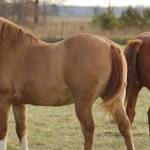Feeding Horses with Acute Laminitis

Laminitis is a severe, painful inflammation of the laminae, which are interlayered tissues that connect the soft and solid structures within the horse’s hoof. Various factors can cause laminitis, with overfeeding of nonstructural carbohydrates (NSC) being one of the most common. Horses with equine metabolic syndrome or Cushing’s disease are at an increased risk for developing laminitis.
Horses with these conditions that develop laminitis should be removed from pasture. Other nutritional trigger factors such as hay and concentrate intake should be reviewed and diet revisions made, if necessary. The horse should be fed low-NSC hay at the rate of 1.5 to 2% of body weight. Alfalfa hay (lucerne) can be part of the diet during the acute stages. Chaff, beet pulp, and soy hulls can provide part of the fiber intake.
If weight loss is required, it is best to stabilize the horse medically before embarking on a weight-loss program with major caloric restriction. Now is not the time to feed just limited amounts of poor-quality grass hay, as the horse needs a balanced diet with all essential nutrients supplied. This can be accomplished by feeding an appropriate ration balancer at a rate of 0.5 to 1 kg (1 to 2 lb) per day to supply amino acids, minerals, and vitamins.
While there are no specific data on its use, some horse owners have tried providing increased amounts of biotin (15 to 30 mg per day), zinc, and methionine to support optimum hoof growth and quality. Increased hoof growth allows more rapid trimming and reshaping of the hoof in the event of coffin bone rotation. For horses that need a higher level of hoof-related nutrients, Kentucky Equine Research offers Bio-Bloom PS (Bio-Bloom HF in Australia) to provide additional support for hoof quality and growth.
As oxidative stress is involved in the laminitis process, higher than maintenance intakes of vitamin E are recommended. Different natural forms are used by manufacturers. Studies have shown that the most effective way of increasing vitamin E status is by using a water-soluble form of natural-source vitamin E, such as Nano-E.








